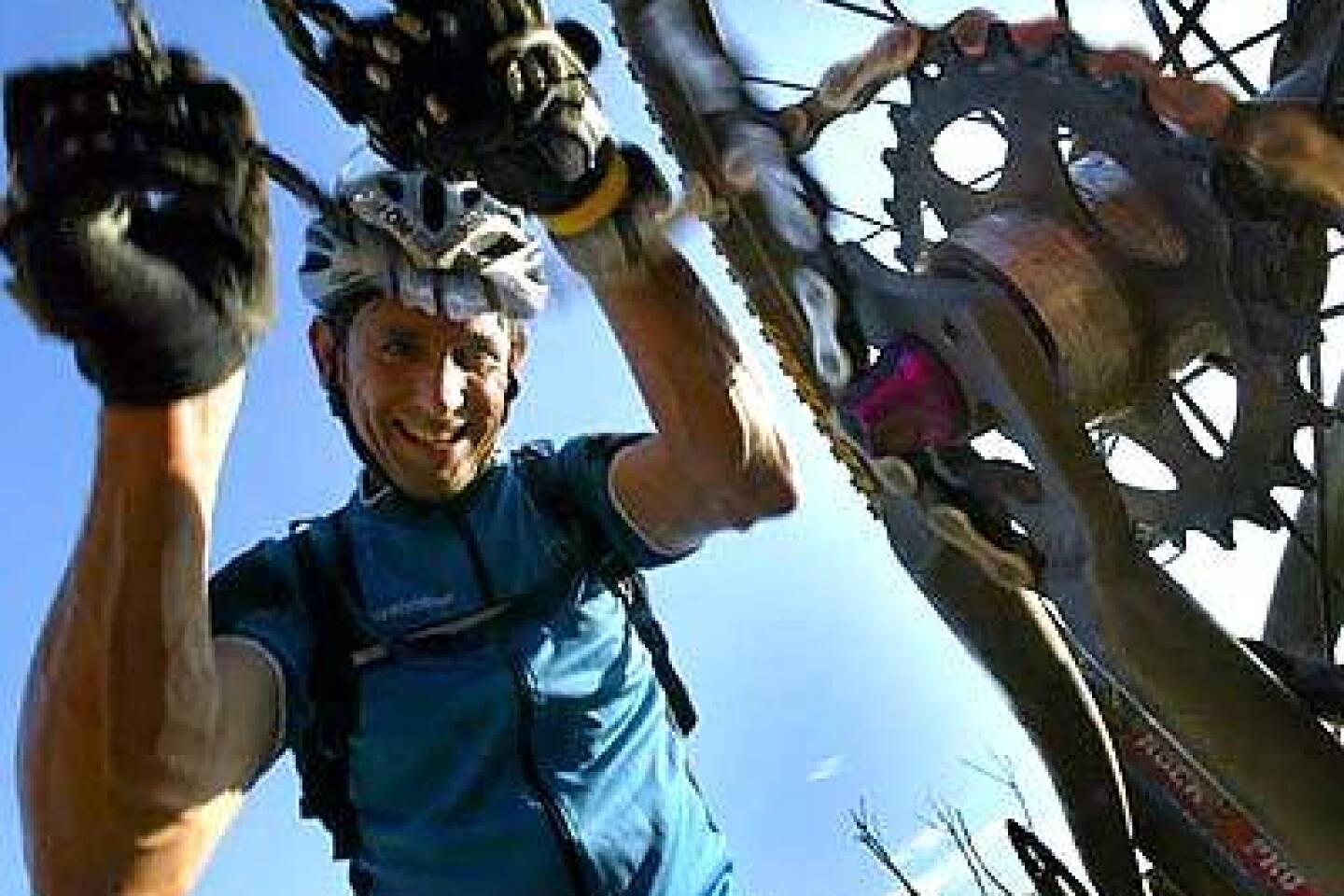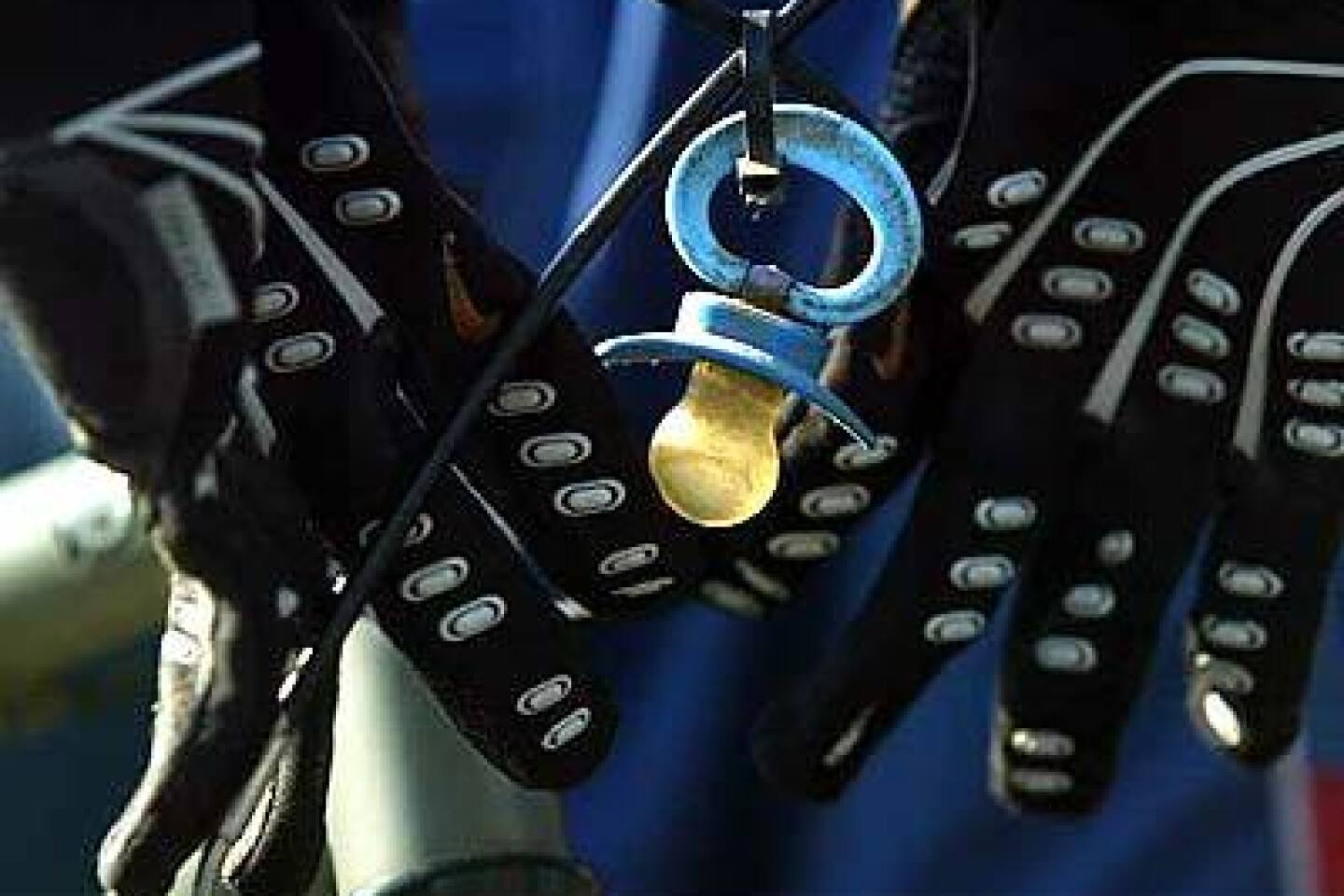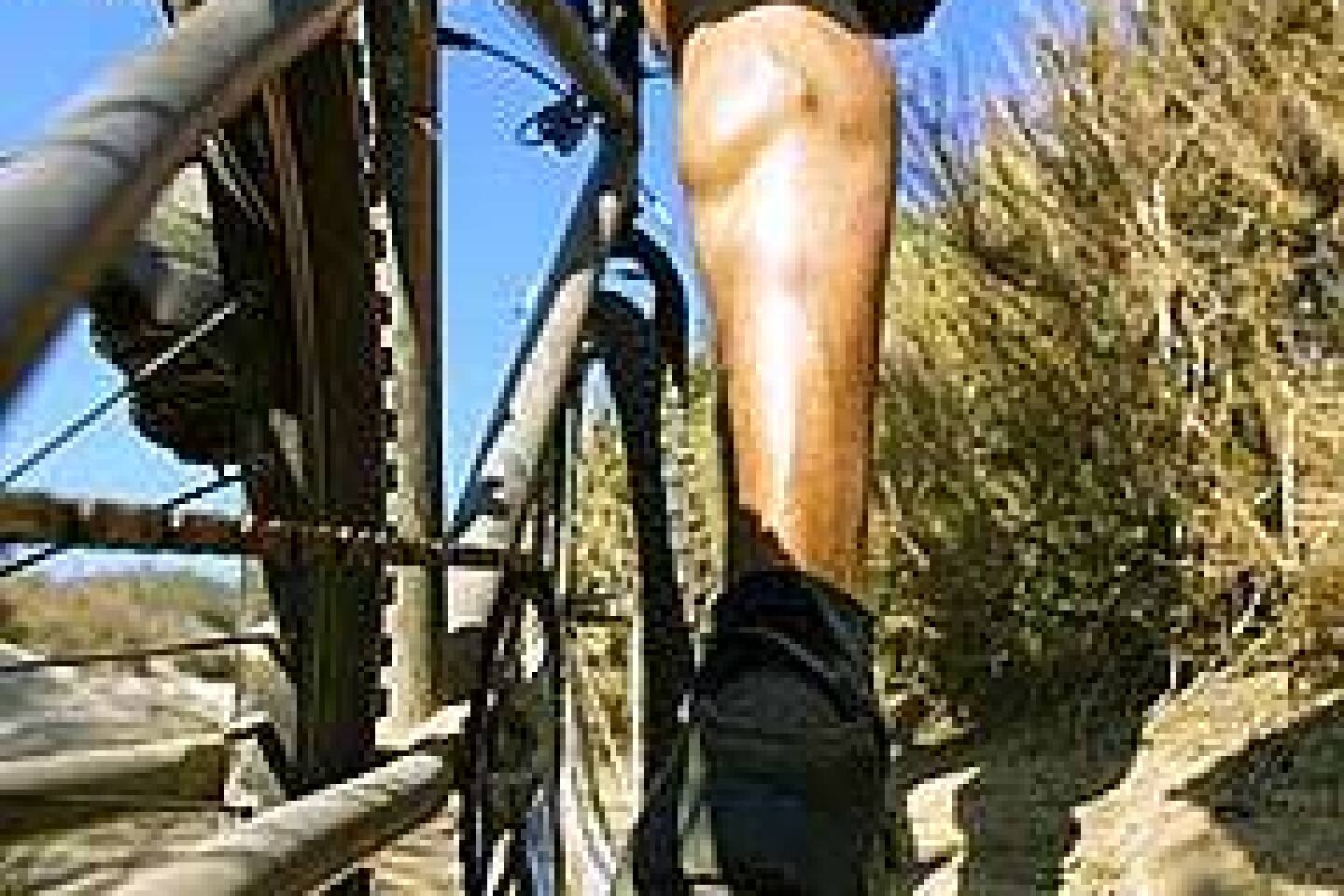Ungeared ecstasy
- Share via
Getting back to the basics is not so simple, at least when it comes to our pastimes. Yearnings are apt to collide. What we need in the pursuit of fun is not always the same as what is necessary, is it?
Rock climbers long ago gave up hammers and hardware. Freedivers discovered the quiet sounds of the living reef. Yet countervailing enticements of “progress” continue to pull in the opposite direction. Backpackers lug portable espresso makers, camp showers, computer-GPS altimeter weather stations and evermore what’s-hot whatnots up trails. Joggers — you’ve seen them — sometimes wind up looking like mobile electronics labs.
Now the argument between less and more has come to the bicycle, that most efficient and beguiling of human inventions.
Until just recently, bicycles were unimpeded in a single-minded rocket flight of technological advancement that had reached Saturn en route to yonder edges of the universe.
On mountain bikes, front suspension forks were augmented by vast assortments of rear shock-absorber systems — wet-bath, stable-platform valving, niche specific — plus trigger shifters for more gears than there are letters in the alphabet, along with hydraulic disc brakes and halogen floodlights. Road bikes, fabricated from witches’ brews of spindly aerospace materials, were outfitted with transmitter-computers and push-button 30-speed index shifters. For those who wanted it, an electronically activated automatic transmission became an option on urban hybrids. Recumbents scrambled everything we knew about bicycles except the shape of wheels.
To which some said, whew.
A counter-trend was inevitable. And sure enough, somewhere between the lumbering, if evermore artsy, beach cruiser and the many styled multi-speed marvels of fussy technology, new breeds of lean, sporty, stylish — and simple — bicycles are coming into fashion, both for road and mountain.
Fanatics have led the way, of course. Fearless and fearsome, urban messengers threw away their shifters, and sometimes their brakes, years ago to dare traffic on limber, fixed-gear speedsters. Since then, slightly tamer but also gearless single-speed bikes have gained nearly cult-like underground status. Now, simplicity is going mainstream with cyclists of this new century reaching back to grab the tail of past generations for the sheer pleasure of it.
Technology isn’t disappearing, of course. Far from it. But it’s being asked to defend itself.
In the process, not just bicycles but attitudes about cycling are being questioned, and refreshed, by those who devote themselves to the pursuit. Editors at Bicycling magazine have long championed advances in machinery, but recently they paused and urged readers to also remember the “poetry” of bikes and not be blinded by the “patents.”
“There is a certain attraction to a minimalist, but still high-end, quality, bike,” said Fred Clements, executive director of the national Bicycle Dealers Assn. “You just get on it and ride, and a lot of people like that.”
So, on the streets, along the parkways and in the mountains, it’s off with derailleurs, cassette cogs, shifters and six feet or so of cables. Leave just one sprocket up front, another in back. One gear, single-speed.
Adherents offer a variety of explanations for this new thinking. They talk about thrift. They talk about ease of maintenance. They talk about common sense or challenge. Unless you ride in the hills, how many gears do you really use anyway? And when you brave the mountains, isn’t the whole idea to push the limits? Why not take it all the way?
Sure, it’s a fad. The best kind: an excuse to buy something shiny in the name of simplifying things. But down at the heart of the matter, there may be more to it. Single-speeders talk about reconnecting. As in, reconnecting to the delights of what it was like to ride as a kid.
“I think the trend stems from experienced riders who became burned out on all the technology that was outdating itself every couple of years,” said Nick Sande, a bicycle designer and, as his business title says, company “stooge” at Surly bikes, a small Minneapolis firm that is a pioneer in bicycles designed specifically as single-speeds. “A lot of people are out there reliving their childhoods.”
Definitions: A single-speed bike retains a coaster hub, or freewheel, but no gears. That means the rider can coast along at will. The fixed gear is a single-speed without a coaster hub. The rider’s legs move constantly with the revolution of the wheels and also provide resistance for slowing.
Typical single-speed riders, Sande said, are keen cycling enthusiasts with at least one or two other bicycles in their garages. They also are likely to be men and women with a sense of humor and a powerful thirst for beer — calories burned en route to a pub justifying the trip, that sort of thing. The Web zine Single Speed Outlaw, for example, field tests equipment in a “junk drawer” page and reviews beers in its “taproom.” Likewise, this year’s single-speed championship races in Berlin were publicized by a sprocket-and-stein logo.
“There is a little of the angry-young-men image to single-speeds, and now you’re finding doctors, lawyers and other professionals looking to get a taste of it,” said Karl Hasenjaeger, service manager at the Path in Tustin, one of the few bike shops in the region with expertise in single-speeding.
Several signs suggest the single-speed phenomenon isn’t a passing fancy. Some of the global behemoths in bicycle manufacturing are now producing their own versions for mass consumption. Custom-frame builders are offering exotic specimens, complete with a beer opener if you don’t want to be caught without. Single-speed bikes can be purchased for a few hundred dollars or many thousands, and in assorted manifestations — from twitchy track and road models to stouter cyclocross versions to beefy hard-tail mountain bikes. Single-speed retrofit kits also are available for those old 10-speeds rusting in the garage.
Enthusiasts in Canada, England, Finland, Italy and China are among the more than 1,100 aficionados who have posted pictures of their bikes and offered testimonials on the website https://www.fixedgeargallery.com .
This summer, Michael Browne, editor of the mountain biking magazine Dirt Rag, wrote a meditation on the state of bicycling titled “Stepping Back to Find the Future.”
Browne explained that he was too young to have enjoyed the free-spirited birth of mountain biking in the 1970s. But interviews with Marin County pioneers of the sport left him longing for that bygone feeling, “so innocent, so pure,” without the distractions of high-stakes marketing and professionalism, “just some guys, playing in the dirt .”
In an interview, Browne said he believed that single-speeders were determined to reclaim balance in life. “They are back to riding just for riding’s sake.”
After all, play is the part of life where we have the greatest leeway to follow our hearts, if not necessarily our common sense.
“Retro,” “anti-technology, “fashion,” “practical and stylish” — these are the words that Kai Matsuda used to describe the tastes of his clientele at Berkeley’s quirky and trend-setting bike shop Momovelo. Matsuda’s simple but uncommonly distinctive single-speed urban runabouts, like the Cheeseboard and the Milktea, are coveted by messengers and “hipster grad students” in communities that define bicycle trends: the Bay Area, Manhattan, Seattle, Portland and Minneapolis.
Southern California may lag the pack, but the idea is catching on.
“Five or six years ago, I’d see one or two single-speeds a month. Now I know whole groups of people who used to ride geared bikes and have given them up,” said Gabriel Zink, a single-speeder and professional bicycle mechanic in Orange County.
On Thursday evenings, Zink and a loose band of hardy — some would say, foolhardy — riders gather in foothills to test themselves against some of the region’s steepest off-road trails without gears.
“I don’t even have a geared cross-country bike anymore,” said the 26-year-old Zink. “I’ve already been up all the trails, so what’s the challenge in that?”
There is nothing, he explained, quite like horsing and sweating your single-speed up grades, passing riders on bikes that are geared for anything. “They feel like crap. And that,” he said with a sidelong smile, “has the effect of making you feel good.”
Surprisingly, this is not just a pursuit of the young. Perhaps half of the riders who meet here weekly are longtime cyclists with evidence of road-wear on their faces, not just their legs. Gerrit Slingerland, 47, grew tired of finicky technology five years ago and retired his gears and suspension. So have his cycling buddies. “We’ve been through the whole range of stuff and now we’re getting back to the roots of the thing.”
So far, no one has proven that the simple, carefree abandon of youth can be found at the end of the single-speed trail. But at a pace that is both swift and unhurried, plenty of riders believe they are headed in the right direction.











